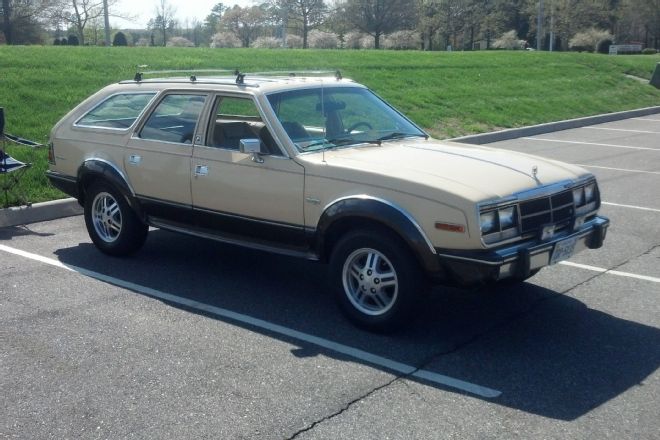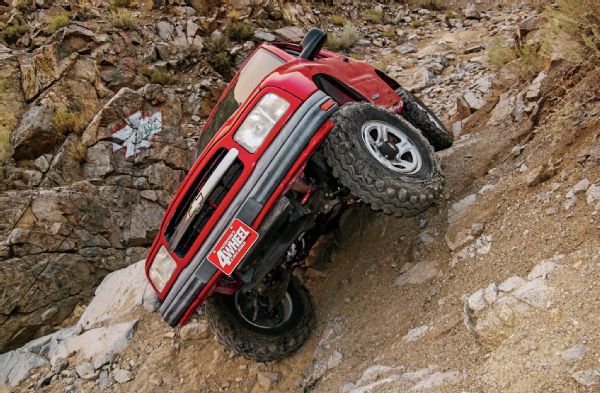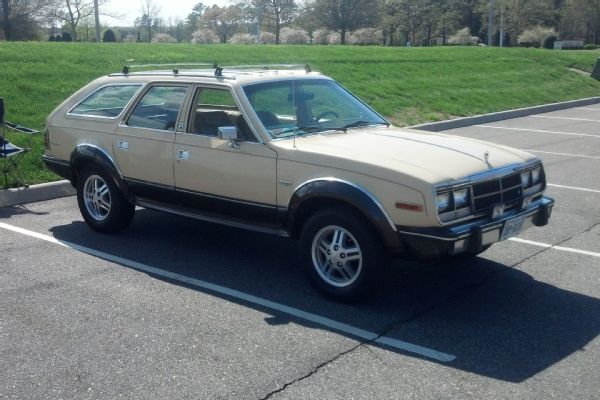
Stumbling Chevy
I'm having an issue with my 1995 Chevy K2500. Under heavy load the TBI 454 dies. When I spray starter fluid in it, the engine fires but doesn't stay running. This leads me to believe the problem is with fuel delivery. The trouble is that the issue is intermittent, so it's hard to diagnose. It runs fine most of the time, but it does this pretty consistently when heavily loaded. Where should I begin?
Harry W.
Via nuts@4wheeloffroad.com
I agree with your assessment that the problem is most likely fuel delivery. Since it runs just fine until its heavily loaded and will run on starting fluid once it dies, then the engine is most likely starved for fuel. Fortunately there are a couple of easy things to do that can help pinpoint the problem.
The first thing to check is the fuel filter. The fuel pressure regulator on your TBI Chevy is in the throttle body itself rather than near the pump, which means that there's a nearly continuous loop of fuel going through the filter. This design makes the system particularly susceptible to a clogged filter. Replacing the fuel filter is cheap and easy on those trucks, so that would be the place to start.
If the filter checks out OK and the problem persists, the next step is to check fuel pressure. There is no test port on TBI Chevys, so you'll need to figure out a way to plumb a gauge in-line with the fuel system. The good news is that you can usually rent a fuel pressure test kit from an auto parts store, and most of the time those kits come with the necessary adapters to hook up a gauge. For reference, the pressure line on the back of the throttle body will be slightly larger in diameter than the return line. The proper fuel pressure for a TBI Chevy is 12-15 psi; the engine will run with as few as 5 psi, but rough. If the fuel pressure is low, then most likely the pump is bad. You can verify this by locating a soft section of the return line and squeezing it off with a pair of needle-nose pliers. If the pressure stays the same, the problem is with the pump. If the pressure spikes, then the problem is the regulator in the throttle body. Keep in mind that those regulators are not known for going bad.
As you might have already guessed, the fuel pump is in the tank, so replacing it means either dropping the tank or lifting up the bed on your pickup to reach the top of the tank. Depending on how your truck is equipped and how much fuel is in the tank, moving the bed may be easier. The fuel pump is part of the fuel pickup and sender assembly, but it is possible to replace just the pump without replacing the whole unit. There may be a short piece of rubber hose between the pump and the rest of the pickup assembly depending on the fuel pump assembly on your truck . This piece of hose likes to break down and rupture, especially with today's ethanol fuel blends. That $2 piece of hose is what brought down my TBI-equipped motorhome not long ago. Even if that piece of rubber hose is the culprit, I would still strongly suggest replacing the fuel pump and, further, replacing it with a factory AC Delco unit (even full retail from a dealer is under $100). Lastly, make sure you replace that piece of rubber hose with submersible fuel hose and not the off-the-shelf hose, or you'll be replacing the hose again in about a year.
More Tracker Tech
I have a 2001 Chevy Tracker ZR2. My plan is to add a 2-inch suspension lift and a 2-inch body. Will I be able to clear larger tires like 31s or 32s on a 15-inch rim?
Dave P.
Via nuts@4wheeloffroad.com

If you haven't yet, you need to check out the build former staffer and frequent contributor Harry Wagner did on a 1999 Tracker, which is basically the same as your 2001. You can check it out on our Four Wheeler network at fourwheeler.com. With that build, Wagner added a 2-inch suspension lift and trimmed a lot of sheetmetal to clear some 31-inch-tall tires on 16-inch wheels, but you could easily use 15-inch wheels instead. You could combine the suspension lift with a 2-inch body lift and trim a lot less sheetmetal, but most likely trimming would still be needed. I'd lean more toward trimming than the body lift, but that's largely due to personal preference. Throw some low-range gears and maybe a locker at your Tracker and you'll have the ultimate budget wheeler.
Shifty Linkage
I have a 1998 Jeep Wrangler with a 4.0L, automatic transmission, and an NP231 transfer case. I went 4-wheeling last weekend and must have hit something because when I went to shift it out of low range, nothing happened! It's like the lever isn't connected to anything anymore and the Jeep is now stuck in low range. The Jeep has a mild lift, but other than that it's stock. How do I get it back into 2-wheel drive? Help!
Rodney B.
Via nuts@4wheeloffroad.com
More than likely one of the rods popped off in the linkage assembly between the shift lever on the transfer case and the lever on the floor. The transfer case shift linkage on a TJ isn't the best design in the world. A pivoting shaft is mounted to the underside of the body at one end and the transmission at the other, so even small changes in the position of the transmission caused by a worn tranny mount or a hit to the belly pan can throw the whole linkage assembly out of whack. The situation is aggravated if there's a drop kit installed in the belly pan to alleviate driveline angles, and your Jeep probably has one considering that it has a lift kit. Most transfer case drop kits come with a bracket to correct the angle of the shift linkage, but it's kind of a pain to install, so it often gets left out or is installed incorrectly. If this is the case, it usually only takes one good 4-wheeling trip for the linkage to come apart.
Chock the tires on your Jeep and crawl underneath. If you look up above the front driveshaft you should be able to see most of the transfer case shift linkage. Look to see if one of the relatively thin metal linkage rods has popped loose; if you find one just hanging on one end, it should be pretty easy to tell where it's supposed to be hooked up. There are also supposed to be rubber grommets on each end of the rods where they attach to the rest of the linkage, and if any of those grommets are missing or damaged, the linkage will fall right back apart. If your Jeep is equipped with a transfer case drop kit (spacers between the bottom of the frame and the belly pan), check to make sure there's a bracket in place that corrects the position of the pivoting shaft that runs between the tranny and the body. If that shaft is not fairly level with the Jeep on flat ground, then the necessary bracket is missing or installed incorrectly, or it's possible that you bent the belly pan up on your trip. Address this as necessary, or better yet, use this as an excuse to upgrade to a slip-yoke eliminator kit and ditch the drop kit entirely. Make sure you keep the tires chocked and the e-brake on at all times while you’re messing with the linkage, as you could accidently pop the transfer case into neutral.
Fly Like an Eagle
I have an unusual 4x4. It's a 1983 AMC Eagle Wagon. The factory tire size is 195/75-R15, with 215/65-R15 as an option, both on 15x6 aluminum wheels. There were 205/75-R15s on the car when I got it but they were just slightly too tall and rubbed on occasion. I am currently running 215/70-R15 all-season tires without issues. What would you recommend for a tire and tire size that is a little more aggressive than the typical all-season tire?
Rich Comer
Via nuts@4wheeloffroad.com

Cool car! It looks like it’s in fantastic shape. I know several AMC fanatics who would love to take that off your hands, myself included. Unfortunately, the news is not good on a more aggressive tire for your Eagle. I wasn't able to find any kind of all-terrain or mud-terrain tire in either of the sizes that you've run on the car. In fact, the difference in those sizes is very small. A 205/75-R15 should be 27.1 inches tall and 8.1 inches wide, while a 215/70-R15 is 26.9 inches tall and 8.5 inches wide. If anything, I would guess that the wider tire would create the clearance issues, but the exact opposite is the case. With such a minor difference, it's possible that the clearance issues you had with the 205s were simply the result of going from one tire brand to another. Tires rarely measure exactly what is printed on the sidewall, so two tires from two different manufacturers with the same size printed on the sidewall most likely will not be the same height and width when you measure them.
Your choices are to do some fender trimming or come up with some kind of lift kit in order to make room for the slightly larger tire size that is available in a more aggressive tread, such as a 235/75-R15. As you can imagine, lift kits for Eagles aren't exactly a hot commodity. Nothing is available off the shelf to raise yours in order to clear larger tires. Further, the IFS suspension doesn't respond well to increased ride height; at most, you might be able to go up an inch or two. As for trimming, you might be able to create additional clearance with some fender modifications, but I hesitate to suggest anything drastic with such a prime example of early 1980s AMC technology.
If I were you I would simply enjoy the cool factor of cruising around in a unique vehicle. Plus, there's bound to be plenty of other things to tinker with on an early 1980s AMC product just to keep it in good running order.